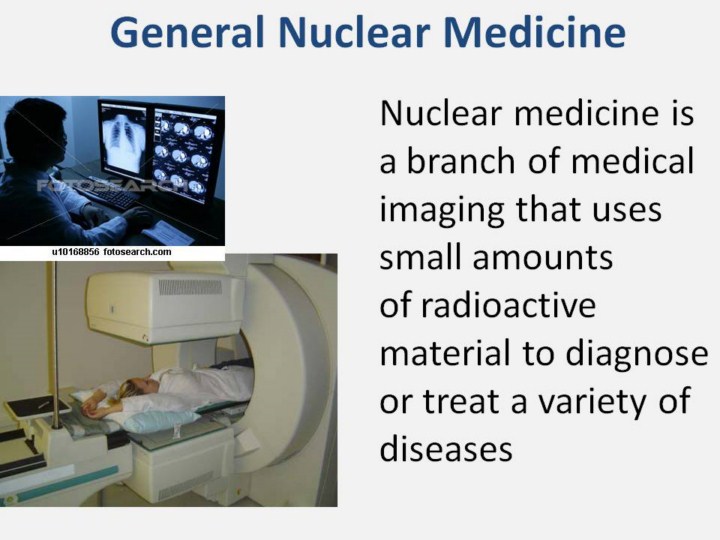| front |1 |2 |3 |4 |5 |6 |7 |8 |9 |10 |11 |12 |13 |14 |15 |16 |17 |18 |19 |20 |21 |22 |23 |24 |25 |26 |27 |28 |29 |30 |31 |32 |33 |34 |35 |36 |37 |38 |39 |40 |41 |42 |43 |44 |45 |46 |47 |48 |49 |50 |51 |52 |53 |54 |55 |56 |review |
 |
Nuclear medicine is a branch of medical imaging that uses small amounts of radioactive material to diagnose or treat a variety of diseases, including many types of cancers, heart disease and certain other abnormalities within the body. Nuclear medicine or radionuclide imaging procedures are noninvasive and usually painless medical tests that help physicians diagnose medical conditions. These imaging scans use radioactive materials called radiopharmaceuticals or radiotracers. Depending on the type of nuclear medicine exam you are undergoing, the radiotracer is either injected into a vein, swallowed or inhaled as a gas and eventually accumulates in the organ or area of your body being examined, where it gives off energy in the form of gamma rays. This energy is detected by a device called a gamma camera, a (positron emission tomography) PET scanner and/or probe. These devices work together with a computer to measure the amount of radiotracer absorbed by your body and to produce special pictures offering details on both the structure and function of organs and tissues. In some centers, nuclear medicine images can be superimposed with computed tomography (CT) or magnetic resonance imaging (MRI) to produce special views, a practice known as image fusion or co-registration. These views allow the information from two different studies to be correlated and interpreted on one image, leading to more precise information and accurate diagnoses. In addition, manufacturers are now making single photon emission computed tomography/computed tomography (SPECT/CT) and positron emission tomography/computed tomography (PET/CT) units that are able to perform both imaging studies at the same time. Nuclear medicine also offers therapeutic procedures such as radioactive iodine (I-131) therapy that uses radioactive material to treat cancer and other medical conditions affecting the thyroid gland. Nuclear medicine is a branch or specialty of medicine and medical imaging that uses radioactive isotopes (radionuclides) and relies on the process of radioactive decay in the diagnosis and treatment of disease. In nuclear medicine procedures, radionuclides are combined with other chemical compounds or pharmaceuticals to form radiopharmaceuticals. These radiopharmaceuticals, once administered to the patient, can localize to specific organs or cellular receptors. This unique ability of radiopharmaceuticals allow nuclear medicine to diagnose or treat a disease based on the cellular function and physiology rather than relying on the anatomy. Nuclear medicine is uniquely suited to tissue charac terisation, early assessment of the extent and severity of disease, and treatment of disease with specific ligands. The methods have wide clinical applications and potential for future developments, having already offered new insights in the understanding of the dementias, the spread of cancer, and the early detection of coronary-artery disease. www.thelancet.com/series/nuclear-medicine http://en.wikipedia.org/wiki/Nuclear_medicine
What are the benefits vs. risks? Benefits The information provided by nuclear medicine examinations is unique and often unattainable using other imaging procedures. For many diseases, nuclear medicine scans yield the most useful information needed to make a diagnosis or to determine appropriate treatment, if any. Nuclear medicine is less expensive and may yield more precise information than exploratory surgery. Risks Because the doses of radiotracer administered are small, diagnostic nuclear medicine procedures result in low radiation exposure, acceptable for diagnostic exams. Thus, the radiation risk is very low compared with the potential benefits. Nuclear medicine diagnostic procedures have been used for more than five decades, and there are no known long-term adverse effects from such low-dose exposure. Allergic reactions to radiopharmaceuticals may occur but are extremely rare and are usually mild. Nevertheless, you should inform the nuclear medicine personnel of any allergies you may have or other problems that may have occurred during a previous nuclear medicine exam. Injection of the radiotracer may cause slight pain and redness which should rapidly resolve. Women should always inform their physician or radiology technologist if there is any possibility that they are pregnant or if they are breastfeeding their baby.. |